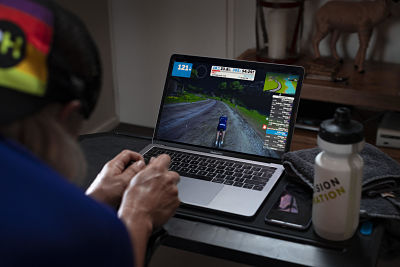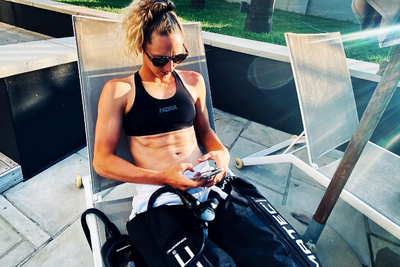In 1993, Graeme Obree attempted to capture the cycling world hour record... failed... before trying again the next morning. Fueled by a hearty breakfast, renewed vigour and the use of his favourite bike, he achieved it.
For most mortals, such swift turnarounds are rarely possible. From a personal perspective, I do a hard session and more often than not I'm left dribbling on the sofa watching re-runs on TV for the rest of the weekend.
Contrary to public perceptions, the human being hasn’t changed much in its performance since the late 20th century. For example, in the book ‘High Tech Cycling’ by Ed Burke, it was calculated that despite the passing of some 50 years, virtually all of the athletes who'd obtained the cycling hour record hadn't actually demonstrated a noticeable improvement in their power output. Think on that before you adopt the supposedly latest and greatest interval session that's ever been conceived.

However, if we can’t get faster, it’s worth being mindful that you can affect your performances by not getting slower. In other words, our focus needs to shift to optimising our recovery.
The faster you can recover, the better the quality of training you can put in, and therefore the closer to the ‘optimal you’ you can get.
Then there's the subject of ageing. As I’ve mentioned before, one of the sad perceptions surrounding growing older is that sooner or later you may well feel you need an extra day or two to get over a tough session.
Things might not be as bad as it seems for all of us though. The book ‘Performance Cycling: The Science of Success’ highlights a study of cyclists that performed three consecutive daily time trials, which showed broadly the same recovery rate between both young and old. That’s good news but bear in mind that cycling is a very low load-bearing sport.
If you do something like running or heavy lifting (i.e. a sport that has a greater bodyweight impact or that one that requires maximal strength), the situation is likely to be different and recovery is going to be more important as you get older.
My advice here is that irrespective of age or ability you should be considering actively weaponising your recovery process and not see it merely as an afterthought or something that only elite athletes do.
The problem is that recovery strategies are as steeped in mysticism and marketing as they are in scientific rigour, so I thought I’d summarise a few options for you and then hit my sofa to drink chocolate milkshakes all day (which I can sell to my family as all being in the name of science)...
1. Massage
Massage has long been proposed as a great way to ease sore muscles, remove lactate and assist in blood flow – thereby improving your recovery. The research historically supported this, but has begun to soften its stance of late by suggesting that some of the benefits may well be as much psychological or obtained as easily with active recovery.
My opinion is always that if you think it works and you have found it has aided your performance, it shouldn't be dismissed out of hand, irrespective of what the studies say. Plus, with the advent of massage guns, it’s become a practical and affordable way to do it yourself.
Note: My first experience of a massage gun was watching a friend take an electric power tool they had, stick a tennis ball on its tip and then hammer themselves with it once they’d crossed the finish line of a triathlon. He was ahead of his time, but those shelves of his weren’t going up anytime soon.
2. Compression clothing
When I started wearing compression clothing 20 years ago, it was a pair of cheap flight socks and a fashion statement that made me look like Pippi Longstocking.
The basic premise of modern day compression wear is that by compressing your muscles or extremities of your body, it improves blood flow and its ‘venous return’. The idea being that you’ll improve your performance during exercise or your recovery from it.
Of the studies that are published, the results vary though. A 2013 review paper concluded that there were small-to-moderate benefits when using compression clothing as a recovery tool, but that they varied according to the physical activity you're doing. The level of significance of using it, scientifically speaking, was also pretty small.

One of the reasons I feel the published studies are so varied in their results regarding its effectiveness are because of difficulties in standardising their fit and function to the test subjects. It’s almost impossible to remove the placebo effect to test it objectively too. The level of contradiction is so high in the evidence that my recommendation is merely to try it and see what you think.
However, whilst I like my technology as much as the next guy, the reality is we can sometimes get too hung up on the gizmos and gadgets, rather than being mindful of the fact that one of the reasons we’re not currently extinct is that we evolved ourselves to be able to eat, survive and do it again when needed.
Our body has many tools at its disposal so in an age of price rises and tightening wallets, let’s take a look at the free options...
3. Sleep
There are actually a range of sleep strategies that athletes can employ to improve recovery. These include sleep extension, napping and sleep hygiene.
A systematic review performed in 2018 analysed 10 studies from a variety of sports and proposed that the best method of sleep to aid your recovery was merely to add some hours to your bedtime. Their results suggested that sleep plays one of the most important roles in some aspects of athletes’ performance and recovery.
The bottom line here is obvious - hit the hay.
4. Cold water immersion / hydrotherapy
Ice baths have been used for years as the basis to reduce inflammations in the body’s tissues after exercise. There's great footage of athletes hopping into wheelie bins or paddling pools filled to the brim with ice and cold water once they’ve finished their event.
I had a memorable experience during a local cycling stage race a few years back. After the first day, I hit the bath tub chocked full of ice cubes. I had visions of waking up energised looking like Dolph Lundgren coming out of cryo freeze in ‘Universal Soldier’, but I was so exhausted that I fell asleep and woke up two hours later. I turned up for the final time trial the next day still wrapped up like I was climbing the Eiger when it was a warm summer’s day.
As far as the science goes though, the changes in blood flow due to the cold temperatures may have an effect on inflammation, immune function, muscle soreness and perception of fatigue. I say ‘may’ because, like massage, it’s been recently proposed that such practise is no more effective at reducing inflammation as alternative methods such as active recovery or merely providing a psychological boost.
The studies also show that like ice swimmer extraordinaire Wim Hof, we can adapt to the cold, thereby reducing its effectiveness over time. My opinion is to do as the pro cyclists do and physically perform a gentle cool down after your event to aid blood flow and lactic acid clearance, and then try cold water immersion occasionally after bigger sessions or events and see if it helps.
5. The day off
I’ve recognised that my emotional state correlates pretty well with how tired I am. If my mood is low and my fuse is getting short with my morning sock choice, it’s time for a day off.
I’m pretty religious about days off anyway – I find taking a day off every weekend gives me a regular mental reset and keeps the family happier (and in my view, a happy home life is the foundation for success).
Others prefer a recovery week every now and then or take a day or two off when they eventually feel like it. All is good if it works for you. The key is that your body super-compensates and improves from your training once you rest it, not when you’re flogging it. We all lose sight of this sometimes but it bears repeating.
So there you go, do a little less to go a little faster and learn to listen to your inner computer.
